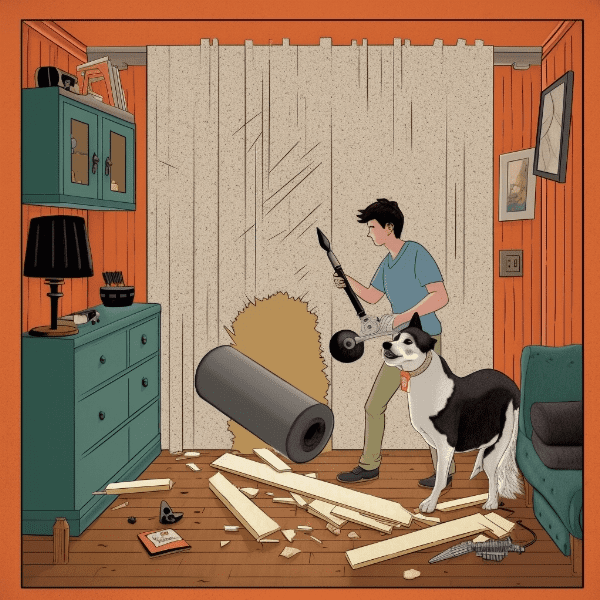Table of Contents
- Understanding the Root Cause of the Problem
- Talking to Your Neighbour About the Issue
- Suggesting Possible Solutions to Your Neighbour
- Installing Soundproofing Materials in Your Home
- Using White Noise Machines or Earplugs to Block Out the Noise
- Seeking Help from Local Authorities or Mediators
- Training Your Neighbour’s Dog to Reduce Barking
- Exploring Legal Options as a Last Resort
- Maintaining a Positive Relationship with Your Neighbour
- Taking Care of Your Own Mental Health During the Process
Understanding the Root Cause of the Problem
When dealing with a noisy neighbour’s dog, it’s important to identify the root cause of the problem. This will help you to determine the best approach to resolving the issue.
Assessing the Dog’s Behaviour
One of the first steps to understanding the problem is to observe the dog’s behaviour. Is the Dog barking constantly, or only at certain times of the day? Is it triggered by specific events or noises? Is the dog left alone for long periods of time? These questions can help you determine if the problem is due to the dog’s behaviour or if there are underlying issues, such as neglect or mistreatment.
Checking for Environmental Factors
Another factor to consider is the environment in which the dog is kept. Is the dog’s living space adequate? Is it exposed to extreme weather conditions or other sources of discomfort? A dog that is uncomfortable or in pain may be more likely to bark excessively.
Communicating with Your Neighbour
In addition to assessing the dog’s behaviour and living conditions, it’s important to communicate with your neighbour about the issue. They may be unaware that their dog’s barking is causing a disturbance, or they may be struggling with their own challenges in caring for the dog. By approaching the issue in a respectful and understanding manner, you may be able to work together to find a solution that benefits everyone involved.
Seeking Professional Help
If the dog’s barking appears to be related to an underlying behavioural issue, it may be beneficial to seek the help of a professional dog trainer or behaviourist. They can assess the dog’s behaviour and provide guidance on how to address the problem.
By understanding the root cause of the problem, you can take steps to address the issue in a more effective and sustainable way. Remember to approach the situation with empathy and patience, and be open to working with your neighbour to find a solution that works for everyone.

Talking to Your Neighbour About the Issue
Approaching your neighbour about their dog’s barking can be a delicate matter. It’s important to remember that they may not be aware of the problem or may have different priorities than you. Here are some tips for having a productive conversation with your neighbour about the issue:
Choose the Right Time and Place
Pick a time when your neighbour is likely to be available and receptive to the conversation. Avoid approaching them when they are in a hurry or during a stressful time. Choose a quiet and private location to have the conversation, away from the dog and any potential distractions.
Be Polite and Respectful
When you approach your neighbour, be polite and respectful. Avoid using accusatory or confrontational language, and instead, focus on the impact that the barking is having on you. For example, you could say something like, “I wanted to talk to you about your dog’s barking. I’m having trouble sleeping at night and I’m wondering if there’s anything we can do to resolve the issue.”
Listen to Their Perspective
It’s important to listen to your neighbour’s perspective and be open to their feedback. They may have concerns or challenges that you are not aware of, and by listening to them, you may be able to find a solution that works for everyone. For example, they may be willing to keep the dog inside during certain hours or invest in training to reduce the barking.
Propose Solutions
Once you have discussed the issue and listened to your neighbour’s perspective, propose some potential solutions. Be willing to compromise and find a solution that works for both parties. For example, you could suggest soundproofing your own home or investing in training to reduce the barking.
Follow Up on the Conversation
After the conversation, follow up with your neighbour to ensure that the agreed-upon solutions are being implemented. If the problem persists, revisit the conversation and see if there are any additional solutions that can be explored.
By approaching your neighbour in a polite and respectful manner, you may be able to find a solution that benefits everyone involved. Remember to listen to their perspective and be willing to compromise to find a solution that works for both parties.

Suggesting Possible Solutions to Your Neighbour
When dealing with a noisy neighbour’s dog, it’s important to approach the situation with a willingness to find a solution that works for everyone involved. Here are some possible solutions that you can suggest to your neighbour:
Training and Socialization
One of the most effective ways to reduce a dog’s barking is through training and socialization. Suggest to your neighbour that they enroll their dog in obedience training or work with a professional dog trainer to address the barking behaviour. They may also want to consider socializing their dog with other dogs and people to help reduce their anxiety and stress levels.
Changing the Living Environment
If the dog is barking excessively due to environmental factors, suggest that your neighbour make changes to their living environment. This may include providing the dog with adequate shelter, food, and water, as well as reducing any potential sources of discomfort or stress. Additionally, they may want to consider adding a sound barrier, such as a fence or wall, to reduce the amount of outside noise that the dog can hear.
Using Anti-Barking Devices
There are a variety of anti-barking devices available that can help reduce a dog’s barking. These may include ultrasonic devices that emit a high-pitched sound when the dog barks, or citronella collars that release a scent that dogs find unpleasant when they bark. Suggest these devices to your neighbour as a possible solution.
Mediation and Conflict Resolution
If the issue cannot be resolved through direct communication, suggest that your neighbour consider mediation or conflict resolution services. These services can help both parties work together to find a solution that works for everyone involved.
Seeking Help from a Professional
If the problem persists, your neighbour may want to consider seeking help from a professional mediator, lawyer, or other third-party service provider. These professionals can provide objective advice and help both parties find a solution that works for everyone.

Installing Soundproofing Materials in Your Home
Identify the Source of the Noise
Before you begin installing soundproofing materials, it’s important to identify the source of the noise. This will help you determine which areas of your home need to be soundproofed. For example, if the noise is coming through a shared wall, you may want to focus on soundproofing that area.
Choose the Right Materials
There are a variety of soundproofing materials available on the market, including acoustic panels, soundproof curtains, and acoustic foam. Choose the materials that are best suited for your specific situation and budget.
Install the Soundproofing Materials
Once you have chosen the right materials, it’s time to install them in your home. Follow the manufacturer’s instructions carefully and make sure that the materials are installed securely and effectively. If you are unsure about how to install the materials, consider hiring a professional.
Consider Additional Measures
In addition to soundproofing materials, there are other measures you can take to reduce the amount of noise that enters your home. For example, you could use white noise machines or earplugs to block out the noise, or you could rearrange your furniture to create a buffer between you and the noise.
Monitor the Situation
After installing soundproofing materials, monitor the situation to see if there is a noticeable reduction in the amount of noise that enters your home. If the problem persists, consider revisiting the conversation with your neighbour or exploring other solutions.
By installing soundproofing materials in your home, you can reduce the amount of noise that enters your living space and improve your quality of life. Remember to choose the right materials for your specific situation and budget, and consider additional measures to further reduce the amount of noise that enters your home.

Using White Noise Machines or Earplugs to Block Out the Noise
If you are having trouble sleeping or working due to your neighbour’s noisy dog, you may want to consider using white noise machines or earplugs to block out the noise. Here are some tips for using these methods effectively:
Choosing the Right White Noise Machine
When choosing a white noise machine, consider factors such as volume control, sound quality, and portability. Some machines may offer additional features such as a variety of sound options or a timer function. Choose the machine that best meets your needs and preferences.
Using Earplugs
If you prefer to use earplugs, choose earplugs that are comfortable to wear and provide adequate noise reduction. Foam earplugs are a popular option, but there are also reusable and custom-molded earplugs available.
Placing the White Noise Machine or Earplugs
When using a white noise machine, place it in a location that is close enough to be effective but not so close that it becomes a distraction. If using earplugs, make sure they are inserted correctly and that they are not causing discomfort or pain.
Adjusting the Volume
When using a white noise machine or earplugs, it’s important to adjust the volume to a comfortable level. The goal is to block out the noise without creating additional discomfort or hearing damage.
Being Mindful of Safety
When using a white noise machine or earplugs, be mindful of safety concerns. For example, if you are using earplugs while sleeping, make sure that you can still hear smoke alarms or other emergency signals.
Using white noise machines or earplugs can be an effective way to block out the noise from a noisy neighbour’s dog. Remember to choose the right machine or earplugs for your specific needs and preferences, and be mindful of safety concerns when using them.

Seeking Help from Local Authorities or Mediators
If you have tried talking to your neighbour and exploring other solutions to address their noisy dog, you may want to consider seeking help from local authorities or mediators. Here are some steps you can take:
Contacting Local Authorities
Depending on where you live, there may be local authorities that can help address the issue. This may include animal control, bylaw enforcement, or the police. Contact these authorities to see if they can help mediate the situation or enforce any relevant regulations or bylaws.
Mediation Services
In some cases, mediation services may be available to help resolve conflicts between neighbours. These services can help both parties work together to find a solution that works for everyone involved. Contact your local government or community organization to see if mediation services are available in your area.
Legal Action
As a last resort, you may want to consider taking legal action against your neighbour. This may include hiring a lawyer to help you pursue legal remedies such as an injunction or a claim for damages. However, legal action can be costly and time-consuming, so it’s important to carefully consider all other options before taking this step.
Documenting the Issue
Throughout the process, it’s important to document the issue and keep a record of any conversations or interactions with your neighbour. This documentation can be helpful if you need to pursue legal action or if you need to provide evidence to local authorities or mediators.

Training Your Neighbour’s Dog to Reduce Barking
If your neighbour is willing to work with you to address their dog’s barking, one solution may be to train the dog to reduce barking. Here are some steps you can take:
Identify the Root Cause of the Barking
Before you begin training the dog, it’s important to identify the root cause of the barking. This may include boredom, anxiety, or territorial behaviour. Once you have identified the cause, you can develop a training plan that addresses the specific issue.
Enroll in Obedience Training
Enrolling the dog in obedience training can be a helpful way to reduce barking. A professional dog trainer can provide guidance on how to train the dog to respond to commands such as “quiet” or “leave it.”
Positive Reinforcement
Positive reinforcement techniques such as treats, toys, and praise can be an effective way to encourage good behaviour in the dog. When the dog stops barking, reward them with a treat or a toy to reinforce the behaviour.
Desensitization
Desensitization involves gradually exposing the dog to the source of the barking and training them to become less reactive to it. For example, if the dog barks at passing cars, you could slowly expose them to the cars while providing positive reinforcement for calm behaviour.
Consistency
Consistency is key when training a dog. Make sure that everyone in the household is on board with the training plan and that the plan is being followed consistently.
Time and Patience
Training a dog takes time and patience. Be prepared to invest time and effort into the training process and be patient with the dog as they learn new behaviours.

Exploring Legal Options as a Last Resort
If you have exhausted all other options and the noisy dog continues to be a problem, you may want to consider exploring legal options as a last resort. Here are some steps you can take:
Understanding Relevant Laws and Regulations
Before taking legal action, it’s important to understand any relevant laws and regulations that apply to the situation. This may include local noise bylaws or regulations regarding the care and control of animals. Consult with a lawyer or local authorities to ensure that you have a clear understanding of your legal options.
Collecting Evidence
When pursuing legal action, it’s important to collect evidence that demonstrates the impact of the noisy dog on your quality of life. This may include videos, audio recordings, and statements from neighbours or other witnesses.
Sending a Legal Notice
Sending a legal notice to your neighbour may be an effective way to resolve the issue without going to court. This notice should outline the specific issues that you are experiencing, and provide a clear timeline and consequences if the issues are not resolved.
Filing a Lawsuit
If the problem persists and all other options have been exhausted, filing a lawsuit may be necessary. This can be a complex and time-consuming process, so it’s important to consult with a lawyer and carefully consider all options before taking this step.
Remember that legal action should be considered a last resort, and should only be pursued after all other options have been exhausted. By understanding relevant laws and regulations, collecting evidence, and pursuing legal action in a thoughtful and respectful manner, you may be able to find a solution that works for everyone involved.

Maintaining a Positive Relationship with Your Neighbour
Be Empathetic
Remember that your neighbour may not be aware of the impact their dog is having on you, or may be struggling to address the issue themselves. Approach the situation with empathy and understanding, and be willing to work together to find a solution that benefits everyone involved.
Communicate Clearly and Respectfully
When communicating with your neighbour, be clear and respectful in your communication. Use “I” statements to explain how the noise is impacting you, and avoid blaming or accusing your neighbour. Listen actively to their perspective and be open to finding a solution that works for both parties.
Focus on Solutions
When discussing the issue with your neighbour, focus on finding solutions rather than assigning blame. Work together to identify possible solutions and be willing to compromise to find a solution that works for both parties.
Follow Up
After discussing the issue with your neighbour, follow up to see if any progress has been made. This can help to ensure that the issue is being addressed and that both parties are following through on any agreed-upon solutions.
Show Gratitude
If your neighbour takes steps to address the issue, be sure to show gratitude and appreciation for their efforts. This can help to maintain a positive relationship and encourage continued cooperation in the future.
By maintaining a positive relationship with your neighbour, you can work together to find a solution that benefits everyone involved. Remember to approach the situation with empathy and respect, and be willing to work together to find a solution that works for both parties.

Taking Care of Your Own Mental Health During the Process
Dealing with a noisy neighbour’s dog can be a stressful and frustrating experience, and it’s important to take care of your own mental health throughout the process. Here are some tips for doing so:
Practice Self-Care
Make time for activities that help you relax and de-stress, such as exercise, meditation, or spending time in nature. Take care of your physical health by eating well, getting enough sleep, and avoiding excessive alcohol or caffeine.
Seek Support
Talk to friends or family members about the situation and how it’s impacting you. Consider joining a support group or seeking the help of a therapist or counsellor if you need additional support.
Set Boundaries
Set clear boundaries with your neighbour and others involved in the situation. This may include establishing quiet hours or creating a buffer zone between your living space and the source of the noise.
Take Breaks
If the situation becomes overwhelming, take a break from the situation. Go for a walk, spend time with friends, or engage in a hobby or activity that brings you joy.
Reframe Your Thinking
Try to reframe your thinking about the situation and find a positive perspective. For example, you may view the situation as an opportunity to practice empathy and communication skills, or as a chance to learn more about conflict resolution.
By taking care of your own mental health throughout the process, you can better cope with the stress and frustration of dealing with a noisy neighbour’s dog. Remember to prioritize self-care, seek support when needed, and set clear boundaries to protect your own well-being.




